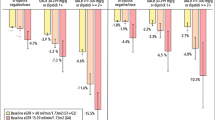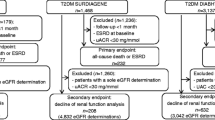Abstract
Background
There is increased interest in surrogate endpoints for clinical trials of chronic kidney disease.
Methods
In this nationwide observational study of 456 patients with type 2 diabetes and clinically suspected diabetic nephropathy followed for a median of 4.2 years, we evaluated the association between estimated glomerular filtration rate (eGFR) and albuminuria at baseline or during follow-up and risk of ESRD.
Results
Low eGFR (<60 mL/min/1.73 m2) and macroalbuminuria at enrollment were independently associated with risk of ESRD. In patients with macroalbuminuria, both ≤−50% change and −50 to −30% change in eGFR over 1 and 2 years were predictive of ESRD. The higher cut point (≥50% decline in eGFR) was more strongly predictive but less common. Remission of macroalbuminuria to normo-/microalbuminuria at 1 and 2 years was associated with a lower incidence of ESRD than no remission; however, it was not a determinant for ESRD independently of initial eGFR and initial protein-to-creatinine ratio.
Conclusion
These results suggest that a ≥30% decline in eGFR over 1 or 2 years adds prognostic information about risk for ESRD in patients with type 2 diabetes and macroalbuminuria, supporting the consideration of percentage decline in eGFR as a surrogate endpoint among macroalbuminuric cases in type 2 diabetes. On the other hand, our study suggests that additional analyses on the relationship between remission of macroalbuminuria and risk of ESRD are needed in type 2 diabetes.



Similar content being viewed by others
References
Tuttle KR, Bakris GL, Bilous RW, et al. Diabetic kidney disease: a report from an ADA consensus conference. Diabetes Care. 2014;37:2864–83.
Committee of Renal Data Registry, Japanese Society for Dialysis Therapy. An overview of regular dialysis treatment in Japan. http://www.jsdt.or.jp/overview_confirm.html. Accessed 13 June 2017.
Coresh J, Turin TC, Matsushita K, et al. Decline in estimated glomerular filtration rate and subsequent risk of end-stage renal disease and mortality. JAMA. 2014;311:2518–31.
Levey AS, Inker LA, Matsushita K, et al. GFR decline as an end point for clinical trials in CKD: a scientific workshop sponsored by the National Kidney Foundation and the US Food and Drug Administration. Am J Kidney Dis. 2014;64:821–35.
Inker LA, Lambers Heerspink HJ, Mondal H, et al. GFR decline as an alternative end point to kidney failure in clinical trials: a meta-analysis of treatment effects from 37 randomized trials. Am J Kidney Dis. 2014;64:848–59.
Lambers Heerspink HJ, Tighiouart H, Sang Y, et al. GFR decline and subsequent risk of established kidney outcomes: a meta-analysis of 37 randomized controlled trials. Am J Kidney Dis. 2014;64:860–6.
Greene T, Teng CC, Inker LA, et al. Utility and validity of estimated GFR based surrogate time-to-event end points in CKD: a simulation study. Am J Kidney Dis. 2014;64:867–79.
Heerspink HJ, Kröpelin TF, Hoekman J, et al. Drug-induced reduction in albuminuria is associated with subsequent renoprotection: a meta-analysis. J Am Soc Nephrol. 2015;26:2055–64.
Furuichi K, Shimizu M, Toyama T, et al. Japan Diabetic Nephropathy Cohort Study: study design, methods, and implementation. Clin Exp Nephrol. 2013;17:819–26.
Matsuo S, Imai E, Horio M, et al. Revised equations for estimated GFR from serum creatinine in Japan. Am J Kidney Dis. 2009;53:982–92.
Levey AS, de Jong PE, Coresh J, et al. The definition, classification, and prognosis of chronic kidney disease: a KDIGO controversies conference report. Kidney Int. 2011;80:17–28.
Matsushita K, Chen J, Sang Y, et al. Risk of end-stage renal disease in Japanese patients with chronic kidney disease increases proportionately to decline in estimated glomerular filtration rate. Kidney Int. 2016;90:1109–14.
Shimizu M, Furuichi K, Toyama T, et al. Long-term outcomes of Japanese type 2 diabetic patients with biopsy-proven diabetic nephropathy. Diabetes Care. 2013;36:3655–62.
Furuichi K, Yuzawa Y, Shimizu M, et al. Nationwide multicenter kidney biopsy study of Japanese patients with type 2 diabetes. Nephrol Dial Transplant. 2017. doi:10.1093/ndt/gfw417.
Skupien J, Warram JH, Smiles AM, et al. The early decline in renal function in patients with type 1 diabetes and proteinuria predicts the risk of end-stage renal disease. Kidney Int. 2012;82:589–97.
Caramori ML, Fioretto P, Mauer M. Low glomerular filtration rate in normoalbuminuric type 1 diabetic patients: an indicator of more advanced glomerular lesions. Diabetes. 2003;52:1036–40.
Shimizu M, Furuichi K, Yokoyama H, et al. Kidney lesions in diabetic patients with normoalbuminuric renal insufficiency. Clin Exp Nephrol. 2014;18:305–12.
Ekinci EI, Jerums G, Skene A, et al. Renal structure in normoalbuminuric and albuminuric patients with type 2 diabetes and impaired renal function. Diabetes Care. 2013;36:3620–6.
Wada T, Haneda M, Furuichi K, et al. Clinical impact of albuminuria and glomerular filtration rate on renal and cardiovascular events, and all-cause mortality in Japanese patients with type 2 diabetes. Clin Exp Nephrol. 2014;18:613–20.
de Boer IH, Afkarian M, Rue TC, et al. Renal outcomes in patients with type 1 diabetes and macroalbuminuria. J Am Soc Nephrol. 2014;25:2342–50.
Yokoyama H, Araki S, Honjo J, et al. Association between remission of macroalbuminuria and preservation of renal function in patients with type 2 diabetes with overt proteinuria. Diabetes Care. 2013;36:3227–33.
Imai E, Haneda M, Chan JC, et al. Reduction and residual proteinuria are therapeutic targets in type 2 diabetes with overt nephropathy: a post hoc analysis (ORIENT-proteinuria). Nephrol Dial Transplant. 2013;28:2526–34.
de Zeeuw D, Remuzzi G, Parving HH, et al. Proteinuria, a target for renoprotection in patients with type 2 diabetic nephropathy: lessons from RENAAL. Kidney Int. 2004;65:2309–20.
Atkins RC, Briganti EM, Lewis JB, et al. Proteinuria reduction and progression to renal failure in patients with type 2 diabetes mellitus and overt nephropathy. Am J Kidney Dis. 2005;45:281–7.
Hovind P, Rossing P, Tarnow L, et al. Remission of nephrotic-range albuminuria in type 1 diabetic patients. Diabetes Care. 2001;24:1972–7.
Japanese Society of Nephrology. Evidence-based clinical practice guideline for CKD 2013. Clin Exp Nephrol. 2014;18:346–423.
Acknowledgements
The authors greatly acknowledge the help and assistance of many colleagues in all participating institutions with collecting the data for the JDNCS. We also sincerely thank Yuka Kuroshima (Kanazawa Medical University) and Yasuhito Imai, Shizuko Takahara, Yu Minagawa, Haruka Tsuzuku (Kanazawa University) for supporting this study.
Author information
Authors and Affiliations
Consortia
Corresponding author
Ethics declarations
Conflict of interest
The authors have declared that no conflict of interest exists.
Human and animal rights
Informed consent was obtained from all participants included in this study. The study protocol was approved by the ethical review board of the JSN (No. 5) and all participating institutions [Kanazawa University (No. 767)].
Funding source
This study was supported in part by a Grant-in-Aid for Diabetic Nephropathy Research from the Ministry of Health, Labour and Welfare of Japan, a Grant-in-Aid for Diabetic Nephropathy and Nephrosclerosis Research from the Ministry of Health, Labour and Welfare of Japan, and a Grant-in-Aid for Practical Research Project for Renal Diseases from the Japan Agency for Medical Research and Development. This study was also supported in part by JSPS KAKENHI Grant no. 17K08979.
About this article
Cite this article
Shimizu, M., Furuichi, K., Toyama, T. et al. Decline in estimated glomerular filtration rate is associated with risk of end-stage renal disease in type 2 diabetes with macroalbuminuria: an observational study from JDNCS. Clin Exp Nephrol 22, 377–387 (2018). https://doi.org/10.1007/s10157-017-1467-9
Received:
Accepted:
Published:
Issue Date:
DOI: https://doi.org/10.1007/s10157-017-1467-9




